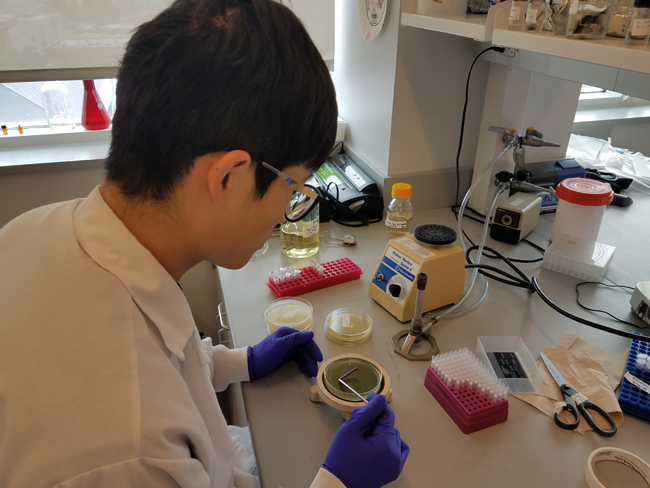
Ruixi Chen, Department of Food Science, Cornell University, plates diluted salmon homogenates to enumerate the level of Listeria monocytogenes on cold-smoked salmon samples. Credit: Jordan Skeens
— By Chris Gonzales, Freelance Science Writer, New York Sea Grant
Stony Brook, NY, January 19, 2022 - Here are over a dozen summaries of published journal articles based on New York Sea Grant–funded research projects …
Water Quality & Health Concerns
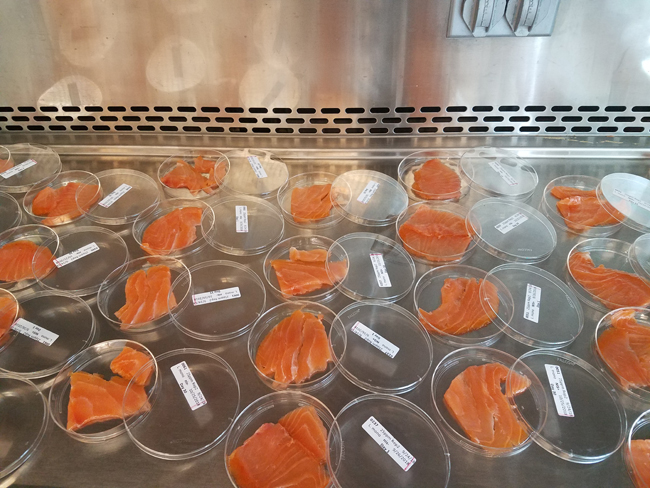
Cold-smoked salmon samples inoculated with Listeria monocytogenes are being air-dried in a biosafety cabinet. Credit: Jordan Skeens
Food Safety and Cold Smoked Salmon
Nisin is a treatment for Listeria, a harmful bacteria, that can be present on cold smoked salmon. This project looks at factors that can influence nisin effectiveness. Their findings show that pre-exposure to a mildly acidic environment, high salt content, and sublethal concentrations of quaternary ammonium compounds, a preservative, combined with nisin, is likely to provide enhanced protection against Listeria. Thus studies that focus exclusively on nisin and a preservative may overestimate the efficacy of nisin treatment on cold smoked salmon.
Chen, R. et al. (2020). Pre-growth conditions and strain diversity affect nisin treatment efficacy against Listeria monocytogenes on cold-smoked salmon. International Journal of Food Microbiology 333 108793. doi.org/10.1016/j.ijfoodmicro.2020.108793
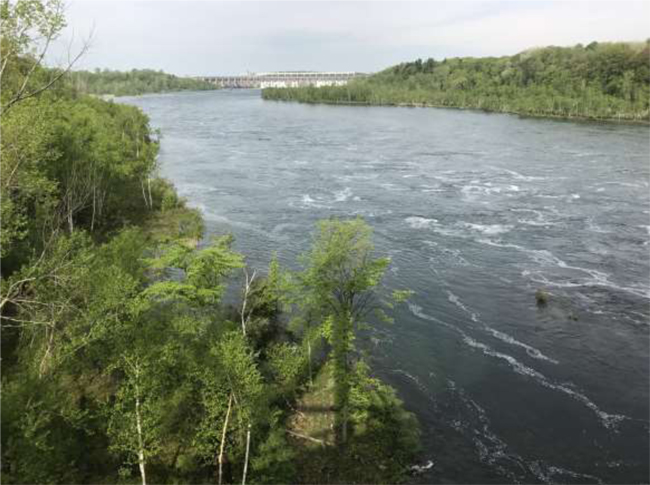
View of the Long Sault dam with sluice gates opened to relieve high water levels on Lake Ontario and the Upper St. Lawrence River. Credit: Michael Twiss
Mercury in the St. Lawrence River
Scientists are studying the potential for mercury to be spread further under new water level management schemes. They’re concerned that a fraction of the total mercury could be transformed into the mobile, active type that gets into the food web.
Brahmstedt, E., et al. (2019). Assessment of mercury mobilization potential in Upper St. Lawrence River riparian wetlands under new water level regulation management. Journal of Great Lakes Research 45 (2019) 735–741. doi.org/10.1016/j.jglr.2019.03.001
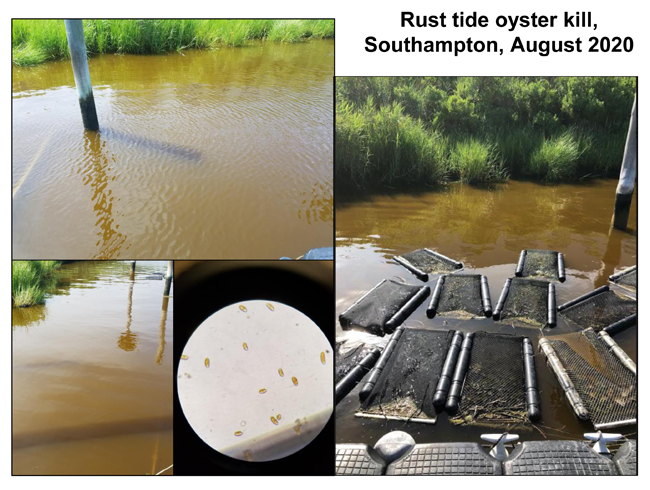
Rust tide (Cochlodinium spp.) oyster kill, Southampton, August 2020. Credit: Christopher Gobler, SoMAS, Stony Brook University
An Organism Behind Harmful Algal Blooms and Its Microbiome
Scientists are trying to understand the chemical pathways by which organisms influence each other’s growth and survival. When it comes to harmful algal blooms caused by the dinoflagellate Cochlodinium polykrikoides, little was known about these pathways. Researchers have used RNA sequencing to assess bacterial and phytoplankton assemblages associated with Cochlodinium blooms, effectively constructing the ‘microbiome’ associated with these blooms, revealing the unique composition and potential function of eukaryotic and prokaryotic communities associated with Cochlodinium blooms.
Hattenrath-Lehmann, T., et al. (2019). Prokaryotic and eukaryotic microbiomes associated with blooms of the ichthyotoxic dinoflagellate Cochlodinium (Margalefidinium) polykrikoides in New York, USA, estuaries. PLoS ONE 14(11): e0223067. doi.org/10.1371/journal.pone.0223067
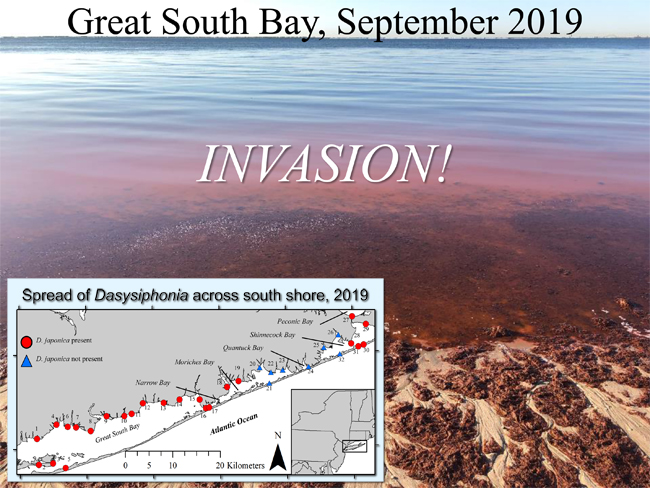
A type of macroalgae, Dasysiphonia japonica, forms in clumps on a beach. As it decays, it releases gases that can irritate the lungs and cause respiratory harm. Credit: Christopher Gobler, SBU SoMAS
Causes of a Macroalga Outbreak
The non-indigenous macroalga, Dasysiphonia japonia, has been cropping up on Long Island shores, and scientists are wondering whether acidic conditions and an excess of nitrogen in the ocean waters contribute to its runaway growth. Its first appearances offshore in the northeastern US were in the late 2000s. This macroalga uses CO2 from the water; this compound becomes an even greater factor for its growth in the warmer months. Estuaries in a eutrophic state (with little life-giving oxygen) and peak annual temperatures greater than 28 degrees Celsius (82.4 degrees Fahrenheit) may be at risk from the rapid spread of this harmful species.
Young. C., & Gobler, C. (2021). Coastal ocean acidification and nitrogen loading facilitate invasions of the non-indigenous red macroalga, Dasysiphonia japonica. Biol Invasions 23, 1367–1391. doi.org/10.1007/s10530-020-02445-9
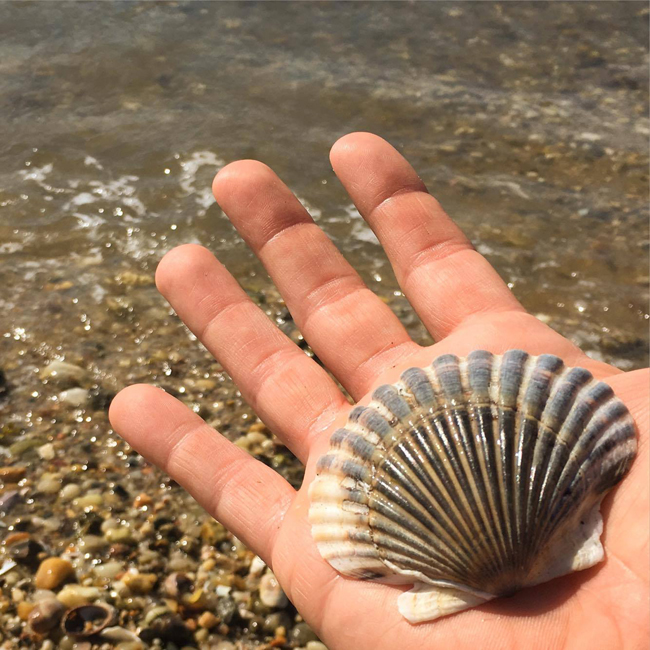
A scallop shell washed ashore in Noyac Bay. Credit: Paul C. Focazio
Beneficial Effects of Green Macroalgae
Scientists are gathering information about how the green macroalgae, Ulva, can reduce the harmful effects of ocean acidification. In tests with elevated CO2 levels, Ulva improved the growth of bivalves (hard clams, bay scallops, and blue mussels.) These results suggest that Ulva may be increasing alkalinity, either through photosynthesis or a nitrate-assimilation process. Thus the conditions created are more favorable for calcium-carbonate–dependent growth of bivalves. For more, see NYSG’s related news item from August 2017, “In Photos: Changes in the Ocean Affect Economically Important Shellfish”.
Young, C., & Gobler, C. (2018). The ability of macroalgae to mitigate the negative effects of ocean acidification on four species of North Atlantic bivalve. Biogeosciences, 15, 6167–6183. doi.org/10.5194/bg-15-6167-2018
Great Lakes and Marine Fisheries
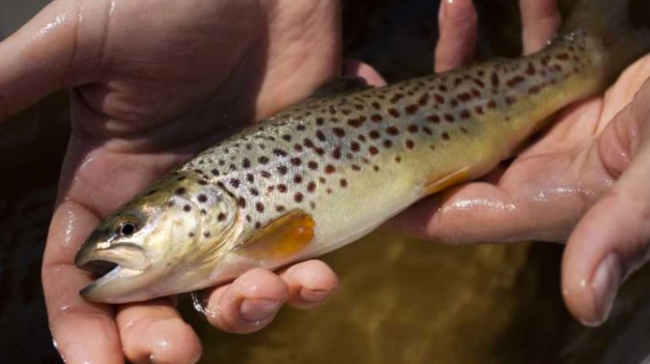
An alewife (Alosa pseudoharengus) caught and tagged by researchers in the Carmans River. Credit: Heather Wals
Discovery of Fish Oscillation Behavior
Scientists tagged alewife to get a more nuanced picture of its spawning migration patterns. In findings representing a reversal of previous thought, 41% of fish made multiple reversals as well as numerous movements on and off the spawning grounds. This “oscillation” behavior, as scientists call it, is likely a naturally-occurring reproductive strategy that has been undetected. Population counts may be off because oscillating fish might be double-counted. For more, see NYSG’s related news item from December 2020, “In Photos: New Details About Fish Migration Could Help Their Conservation”.
McCartin, K. et al. (2019). A New Paradigm in Alewife Migration: Oscillations between Spawning Grounds and Estuarine Habitats. Transactions of the American Fisheries Society 148:605–619. doi.org/10.1002/tafs.10155
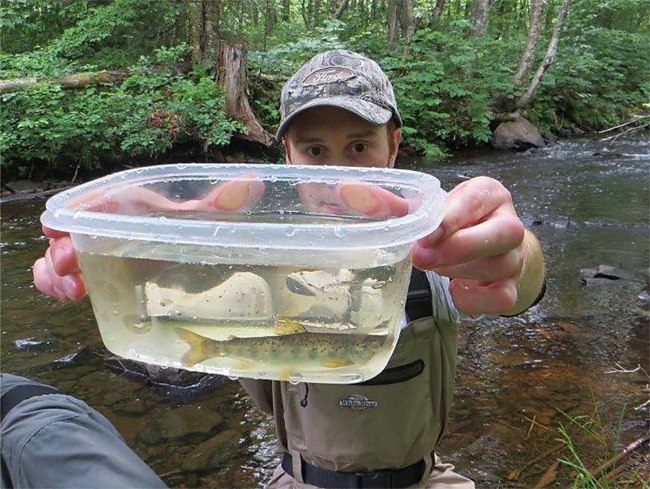
Sea Grant scholar Justin DiRado holding an Atlantic Salmon parr recaptured in Furnace Creek (August 2015)
Feeding Patterns of Salmon
Researchers examined the diets of two types of salmon to determine if they are competing with each other for food. Atlantic salmon tended to feed from the benthos—in this case, the bottom of Lake Ontario and tributary streams. Sub-yearling Chinook salmon, in contrast, tended to feed from the drift—facing upstream to catch passing bits of food1. These results indicate there is little competitive interaction for Chinook and Atlantic species. However, a low availability of chironomids (tiny two-winged flies2) could pose a short-term resource limitation.
Johnson, J., et al. (2016). Diet, feeding patterns, and prey selection of sub-yearling Atlantic salmon (Salmo salar) and sub-yearling chinook salmon (Oncorhynchus tshawytscha) in a tributary of Lake Ontario. J Appl Ichthyol. 2017;33:502–508. doi.org/10.1111/jai.13335

Juvenile Rainbow Trout, as shown in "Salmon and Trout of Lake Ontario: A Visual Identification Guide" (pdf)
Two Fish Share Habitat
Researchers are investigating the seasonal use of a Central New York stream by two types of fish. Slimy sculpin and juvenile rainbow trout share habitat by dividing it, apparently. These findings may be of note for managers of sites where sculpin are being re-introduced.
Johnson, J., et al. (2018). Seasonal Habitat Use of Slimy Sculpin and Juvenile Rainbow Trout in a Central New York Stream. Northeastern Naturalist 25(4):646-655. doi.org/10.1656/045.025.0409
Video from "On YouTube: New Economic Report Identifies Keys to Long Island Growth in Tourism, Fishing" (December 2018)
Recreational Fishing and Public Policy
Participation in saltwater recreational fishing has been increasing over the past two decades. Researchers are trying to understand the components of this demand, to better inform public policy. They determined that there are three types of fishing participant: for-hire; private; and shore. Price changes for angler trips affect for-hire and private mode participation. But overall demand is inelastic—meaning it doesn’t change in response to another economic factor such as price or income3. As policymakers consider changes to fishing regulations, these economic insights will prove useful. For more, see NYSG’s related news item from March 2019, “Building Capacity to Assess Economic Impacts in Long Island’s Coastal Communities”.
Li, S., Vogel, R., & Viswanathan, N. (2019). Demand for saltwater recreational fishing: A generalized demand approach. Ocean and Coastal Management 179 104820. doi.org/10.1016/j.ocecoaman.2019.104820
Shellfish in NY’s Marine Waters

Matt Hare and Harmony Borchardt-Wier anchoring a cage of experimental eastern oysters (Crassostrea virginica) at the Soundview site, East River, NYC in 2012. Credit: Sarah Crestol
Molecular Adaptation and Selection in Oysters
How do species evolve under environmental pressure? How can we look more closely at species’ ability to change in response to environmental change? A group of scientists is asking these questions about the eastern oyster, Crassostrea virginica. They collected oysters from different reefs, some with high salinity, some with low. They found more diverse gene expression (more different types of genes) in the oysters from high-salinity environments. This study is a starting point for using RNA sequencing to predict how organisms might respond to environmental change. For more, see NYSG’s related news item from May 2022,"Molecular Adaptation and Selection in Oysters".
Eierman, L. & Hare, M. (2016). Reef-Specific Patterns of Gene Expression Plasticity in Eastern Oysters (Crassostrea virginica). Journal of Heredity, 90–100. doi.org/10.1093/jhered/esv057
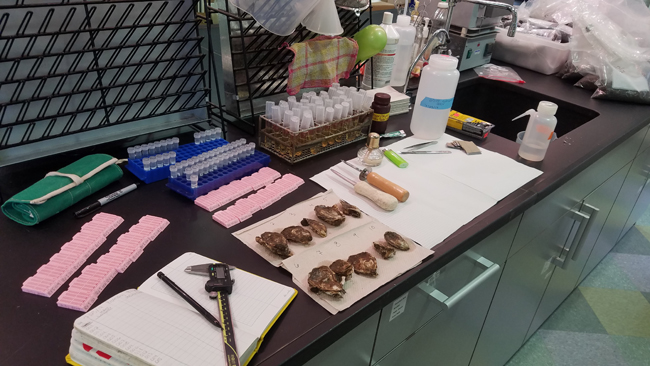
Each individual oyster was measured using calipers (length, width, height) before being dissected. Tissue sections were cut for histological analysis (pink cassettes), sampled for dermo disease analysis (tall tubes), and a tissue section archived for genetic analysis (small tubes in blue racks). Credit: Katherine McFarland, NOAA Federal
Oyster Restoration in Urban Estuaries
In a recent study, Katherine McFarland and coauthors investigated an extensive surviving population of the oyster that was recently found in the Hudson/Raritan Estuary (HRE)—a system of bays and waterways where coastal rivers meet the ocean —near Tarrytown, NY. Their findings about the robustness of this population have big implications for ecological restoration efforts. For more, see NYSG’s related news item from December 2020, “An Urban Estuary Ready for an Oyster Comeback”.
McFarland, K. & Hare, M. (2018). Restoring oysters to urban estuaries: Redefining habitat quality for eastern oyster performance near New York City. PLoS ONE 13(11): e0207368. doi.org/10.1371/journal.pone.0207368
Video from "Stopping the Disease that has Wracked the New York Hard Clam Fishery" (December 2018)
Moving Hard Clams to Safer Waters
Scientists want to know if moving hard clams will help them survive outbreaks of QPX, a catastrophic disease of hard clams. In a field study, the treatments they tried reduced incidence of the disease.
Dahl, S. & Allam, B. (2016). Hard clam relocation as a potential strategy for QPX disease mitigation within an enzootic estuary. Aquaculture Research, 47, 3445–3454 doi.org/10.1111/are.12793
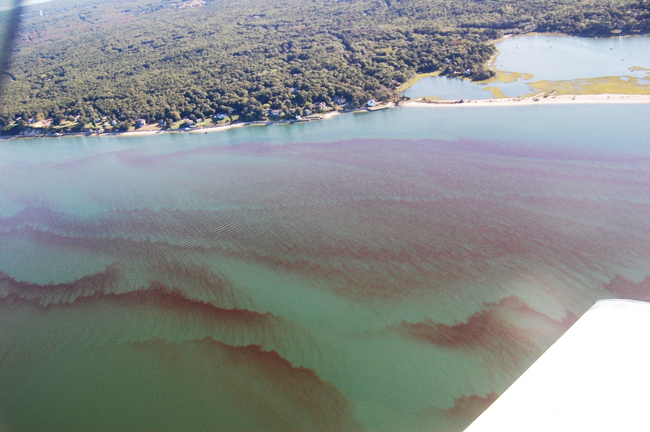
A 2016 toxic ‘rust tide’ in the Peconic Estuary, Suffolk County, NY. Credit: USGC Auxiliary via NYSG
Resistance to Paralytic Shellfish Toxins
Scientists are trying to figure out how common genetic resistance to paralytic shellfish poisoning is in softshell clams. This study finds evidence that Alexandrium blooms can select for resistance to PSP-toxins in softshell clams (M. arenaria). These results have implications for shellfish growers and toxicity monitoring.
Phillips, J., et al. (2018). Biogeography of resistance to paralytic shellfish toxins in softshell clam, Mya arenaria (L.), populations along the Atlantic coast of North America. Aquatic Toxicology 202 196–206. doi.org/10.1016/j.aquatox.2018.06.017
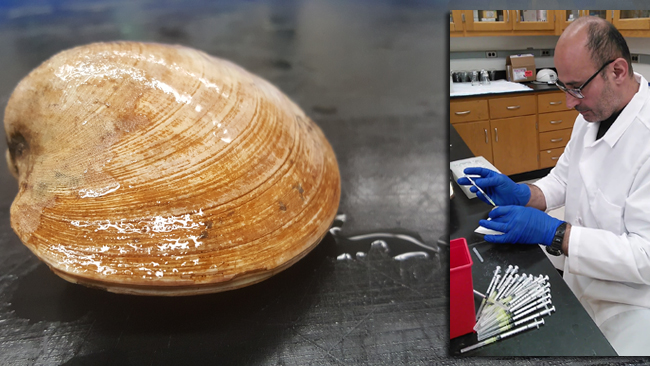
Stony Brook University researcher Bassem Allam collects clam blood in the lab. Credit: Emmanuelle Pales Espinosa, SoMAS, SBU
The Bivalve Virus Genome
Scientists are using RNA sequencing to identify viruses that are associated with marine mollusks. For more, see NYSG’s related news item from March 2021, “RNA Reveals Numerous Viruses of Marine Mollusks”.
Rosani, U., et al. (2019). A Needle in A Haystack: Tracing Bivalve-Associated Viruses in High-Throughput Transcriptomic Data. Viruses, 11, 205; doi.org/10.3390/v11030205
References
1 driftmodelproject.org
2 www.merriam-webster.com
3 www.investopedia.com
More Info: New York Sea Grant
New York Sea Grant (NYSG), a cooperative program of Cornell University and the State University of New York (SUNY), is one of 34 university-based programs under the National Oceanic and Atmospheric Administration’s National Sea Grant College Program.
Since 1971, NYSG has represented a statewide network of integrated research, education and extension services promoting coastal community economic vitality, environmental sustainability and citizen awareness and understanding about the State’s marine and Great Lakes resources.
Through NYSG’s efforts, the combined talents of university scientists and extension specialists help develop and transfer science-based information to many coastal user groups—businesses and industries, federal, state and local government decision-makers and agency managers, educators, the media and the interested public.
The program maintains Great Lakes offices at Cornell University, University at Buffalo, SUNY Oswego and the Wayne County Cooperative Extension office in Newark. In the State's marine waters, NYSG has offices at Stony Brook University and Cornell Cooperative Extension of Nassau County on Long Island; at Brooklyn College, with New York City Department of Environmental Protection in Queens and at Cornell Cooperative Extension in NYC and Elmsford and Kingston in the Hudson Valley.
For updates on Sea Grant activities: www.nyseagrant.org has RSS, Facebook, Twitter, Instagram, and YouTube links. NYSG offers a free e-list sign up via www.nyseagrant.org/nycoastlines for its flagship publication, NY Coastlines/Currents, which is published quarterly.